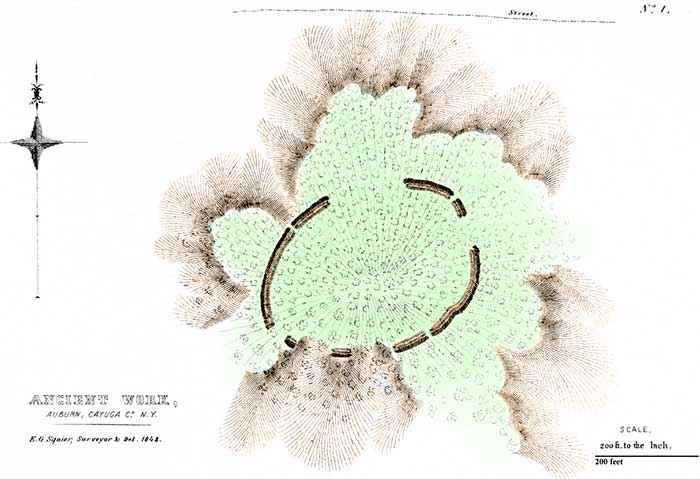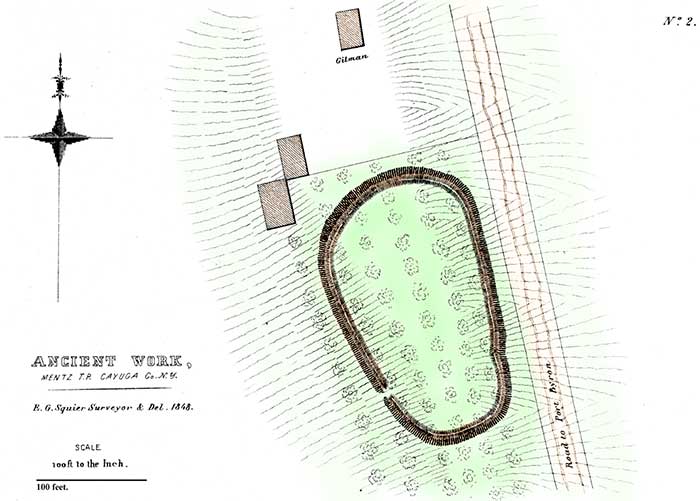CAYUGA COUNTY.

PLATE V. No. 1.
ANCIENT WORK NEAR AUBURN, NEW YORK.
ONE of the best preserved and most interesting works in the State, is that overlooking the flourishing town of Auburn. It is situated upon a commanding eminence, which rises abruptly from the level grounds upon which the town is built, to the height of perhaps one hundred feet. It is the most elevated spot in the vicinity, and commands a wide and very beautiful prospect. The ground occupied by the work subsides gently from the centre of the area; but exterior to the walls are steep acclivities and deep ravines, rendering approach in nearly every direction extremely difficult. These natural features are indicated in the plan, which obviates the necessity for a detailed description. Upon the south are several deep gulleys, separated by sharp, narrow ridges, rendering ascent at this point, in the face of determined defenders, entirely impracticable. It has been conjectured by some that the walls here have been washed away; but it is clear that there was slight necessity for any defences at this point, and that none ever existed beyond what may still be traced.
The number and relative proportions of the gateways or openings are correctly shown in the plan. That upon the north is one hundred and sixty feet wide; that upon the east sixty feet, and that upon the west thirty feet. These wide, unprotected spaces would seem to conflict with the supposition, so well sustained by its remaining features, that the work had a defensive origin. It is not improbable, however, that palisades extended across these openings, as well as crowned the embankments; for without such additions, as has been already observed, the best of these structures could have afforded but very slight protection.
The embankments of this work are now between two and three feet in height, and the trenches of corresponding depth. The area of the work and the ground around it are covered with forest-trees. There are several depressions, which probably were the caches of the ancient occupants.6
It is said that a number of relics have been recovered here from time to time, and among others the head of a banner-staff of thin iron, fourteen inches long and ten broad. It is, of course, of French or English origin, and was probably lost or buried here by the Indians, into whose hands, by purchase or capture, it had fallen. We may perhaps refer it back to the days of Champlain and Frontenac, when the armies of France swept the shores of the western lakes, in the vain hope of laying the foundation of a Gallic empire in America. This relic is now in the possession of Mr. J. W. Chedell, of Auburn.
McCauley, in his History of New York, presents the subjoined facts bearing upon the question of the probable antiquity of this work, which may not be without their interest. He says: "We examined the stump of a chestnut-tree in the moat, which was three feet two inches in diameter, at a point two feet and a half above the surface of the earth. A part of the trunk of the same tree was lying by the stump. As this tree had been cut down, we endeavored to ascertain its age; and for this purpose we counted the rings or concentric circles, and found them to amount to two hundred and thirty-five. The centre of the tree was hollow, or rather decayed; and estimating this part as equal to thirty more layers or growths, we calculated the entire age of the tree to be two hundred and fifty-five years. About five years had elapsed since the tree was cut down. This was in 1825, and would carry back the date of the work to 1555.
"At the distance of three paces from this stump was another of chestnut, standing in the ditch. It exceeded three feet in diameter, and the tree must have died standing, and probably remained in that position many years before it fell from decay. In our opinion, the tree dated back as far as the discovery of the continent. Besides, it may be conjectured, for aught we know to the contrary, that several growths of forest intervened between the abandonment of this work and the date of the present forest."7
About two miles northeast of the work above described, upon elevated ground, was another similar work. It is now entirely levelled, and its site can only be ascertained by the fragments of pottery which are scattered over the ground. It was visible in 1825, when it was visited by McCauley, who says:
"It enclosed about two acres, and had a rampart, ditch, and gateway. It is now nearly obliterated by the plough. In its original state, or the condition it was in thirty-five years ago, about the time the land was cleared, the rampart was seven feet high, and the ditch ten feet wide and three deep. Two persons, the one standing in the ditch, and the other within the enclosure, were unable to see each other. The gateway was on the northeastern side, in the direction of a spring which flowed close by. The work was three hundred and fifty paces in circumference."

PLATE V. No. 2.
ANCIENT WORK, MENTZ TOWNSHIP, CAYUGA COUNTY, NEW YORK.
Six miles northwest of Auburn, and three miles from Troopsville, in the township of Mentz, is the small but well preserved work of which a plan is here given. The country around is hilly, and the work itself is built upon the crest of a narrow ridge, which extends nearly north and south, and along which the main road passes. There is a hollow, with springs flowing into it, towards the left; in which direction, it will be observed, a gateway opens. Although the ground has been for many years under cultivation, the lines of embankment are still between two and three feet high. A quantity of relics, some of comparatively late date, have been found here. Some skeletons, also, have been disclosed by the plough, both within and without the walls. The plan obviates the necessity for any further description.
The existence of this work does not seem to have been hitherto known, beyond the secluded vicinity in which it occurs. It is, however, probable that it is the one alluded to by McCauley in the following very indefinite terms: "On the east side of the Seneca River, near Montezuma, there are still to be seen the ruins of a small fort. A small mound occurs not far from the fort; it is artificial." Montezuma is situated in the same township with the work above described, and about four miles distant, in a northwestern direction. In the "New York Magazine," for 1792, mention is made of a couple of ancient works, said to occur south of Cross and Salt Lakes, east of the Seneca River, and falling probably within the limits of the present township of Brutus, in Cayuga or Elbridge, in Onondaga county. One of these was in the "form of a parallelogram, two hundred and twenty yards long and fifty-five broad, with openings on either side, one of which led to the waters. Half a mile south was another work of crescent form; large trees were growing upon both." Quantities of well burned pottery in fragments were found there; also a slab of stone five feet long, three and a half broad, and six inches thick, upon which were some rude tracings, specimens perhaps of the "picture writing" of the Indians.
McCauley mentions an ancient work near the town of Aurora, in the southern part of this county, and near Cayuga Lake. According to this authority, it was situated "two miles from the village, in a southwesterly direction; the area triangular, and containing two acres. Two of its sides were defended by precipitous banks, and the third by an embankment and ditch. Fragments of earthen vessels and the bones of animals had been found there enveloped in beds of ashes."
There are traces of an ancient palisaded work of the Cayugas, in Ledyard township, about four miles southeast of Springport. In fact, the whole country has numerous vestiges, cemeteries, etc., of its former aboriginal possessors.
6. This work has an accidental approach to regularity; but it is far from being a true ellipsis, as has been supposed by some who have visited it.
7. History of New York, Vol. I., p. 112.

